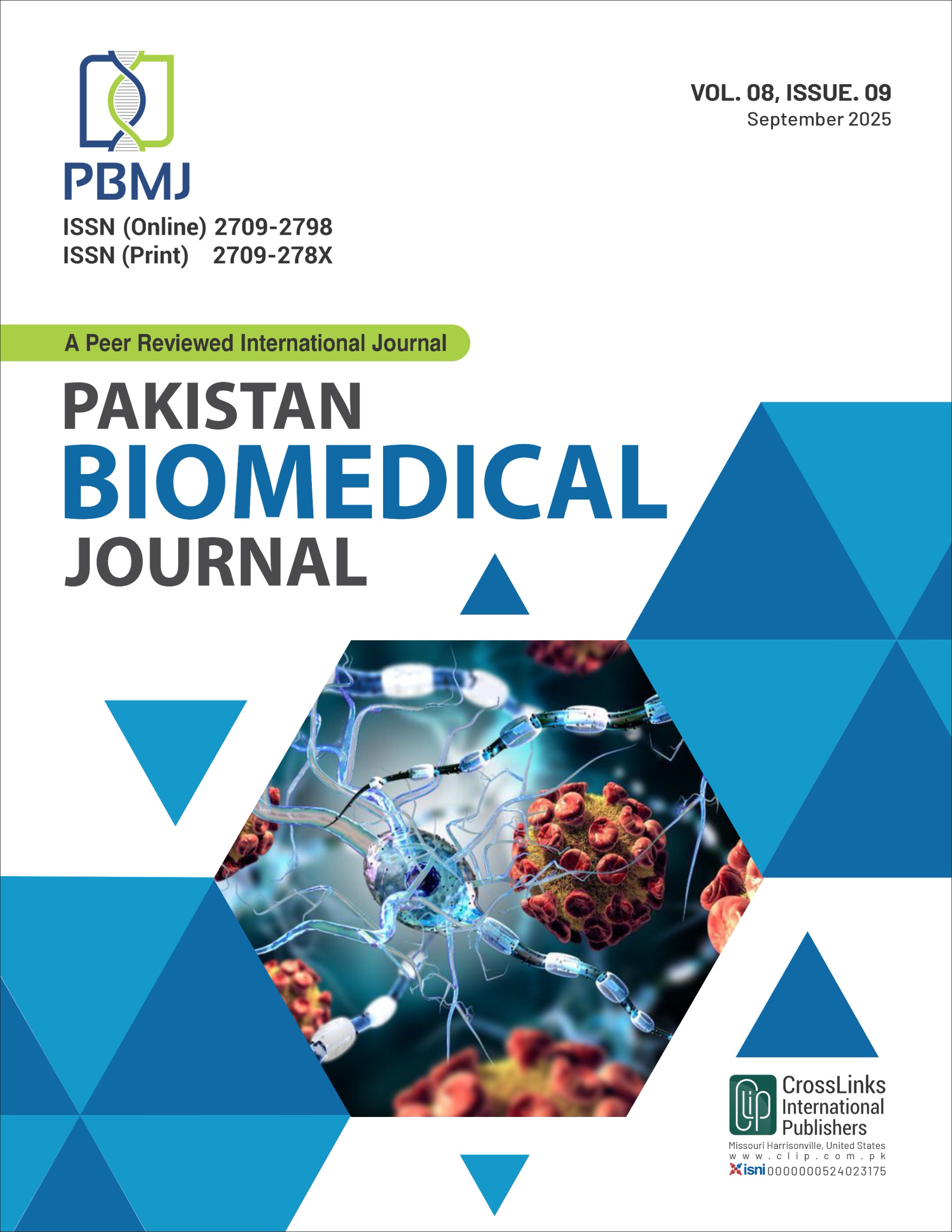Association Between Guyon’s Canal Syndrome and Hypothenar Muscle Weakness Among Call Center Agents: A Cross-Sectional Study
Association Between Guyon’s Canal Syndrome and Hypothenar Muscle Weakness
DOI:
https://doi.org/10.54393/pbmj.v8i9.1266Keywords:
Guyon’s Canal Syndrome, Hypothenar Muscles, Call Centre, Occupational HealthAbstract
Guyon’s Canal Syndrome is an ulnar nerve entrapment often caused by repetitive wrist use and poor ergonomics. Objectives: To investigate the association between Guyon’s Canal Syndrome and hypothenar muscle weakness among call center agents. Methods: This cross-sectional study was conducted on 56 participants using convenience sampling. The study was completed within six months. Data were collected from call center agents in Lahore using Tinel’s sign to assess ulnar nerve irritation, and testing of the hypothenar muscles, abductor digiti minimi, and opponens digiti minimi was performed using Manual Muscle Testing (MMT). Results: A positive Tinel test was noted in 83.9% of subjects. MMT revealed that 60.7% exhibited grade 4 and 35.7% displayed grade 5 strength in the abductor digiti minimi, while 66.1% showed grade 4 and 28.6% demonstrated grade 5 strength in the opponens digiti minimi. A notable negative correlation emerged between Tinel test outcomes and abductor digiti minimi strength (r=–0.442, p<0.001), whereas the correlation with opponens digiti minimi strength was not statistically significant (r=–0.190, p=0.064). Conclusions: The study found a significant negative correlation between Tinel test results and abductor digiti minimi strength.
References
Coniglioli R, Caraballo-Arias Y, Salmen-Navarro A. Epidemiology of Work-Related Musculoskeletal Disorders. Current Opinion in Epidemiology and Public Health. 2022 Nov; 1(1): 18-24. doi: 10.1097/PXH.0000000000000003. DOI: https://doi.org/10.1097/PXH.0000000000000003
Lee W, Lee J, Kim HR, Lee YM, Lee DW, Kang MY. The Combined Effect of Long Working Hours and Individual Risk Factors on Cardiovascular Disease: An Interaction Analysis. Journal of Occupational Health. 2021 Jan; 63(1). doi: 10.1002/1348-9585.12204. DOI: https://doi.org/10.1002/1348-9585.12204
Rigouin P, Ha C, Bodin J, Le Manac'h AP, Descatha A, Goldberg M, et al. Organizational and Psychosocial Risk Factors for Carpal Tunnel Syndrome: A Cross-Sectional Study of French Workers. International Archives of Occupational and Environmental Health. 2014 Feb; 87(2): 147-54. doi: 10.1007/s00420-013-0846-0. DOI: https://doi.org/10.1007/s00420-013-0846-0
Georgiev GP. Hypothenar Muscles and Guyon's Canal. In Muscle Cell and Tissue-Novel Molecular Targets and Current Advances. IntechOpen. 2020 Feb. doi: 10.5772/intechopen.91477. DOI: https://doi.org/10.5772/intechopen.91477
O'Connell C, Guo M, Soucy B, Calder M, Sparks J, Plamondon S, et al. All Hands-on Deck: The Multidisciplinary Rehabilitation Assessment and Management of Hand Function in Persons with Neuromuscular Disorders. Muscle and Nerve. 2025 May; 71(5):869-88. doi: 10.1002/mus.28167. DOI: https://doi.org/10.1002/mus.28167
Silver S, Ledford CC, Vogel KJ, Arnold JJ. Peripheral Nerve Entrapment and Injury in the Upper Extremity. American Family Physician. 2021 Mar; 103(5): 275-85.
Svendsen SW, Johnsen B, Fuglsang-Frederiksen A, Frost P. Ulnar Neuropathy and Ulnar Neuropathy-Like Symptoms in Relation to Biomechanical Exposures Assessed by a Job Exposure Matrix: A Triple Case-Referent Study. Occupational and Environmental Medicine. 2012 Nov; 69(11): 773-80. doi: 10.1136/oemed-2011-100499. DOI: https://doi.org/10.1136/oemed-2011-100499
Malek N. Carpal tunnel syndrome: Etiopathogenesis, Clinical Manifestations, Diagnostics, Options of Treatment, Results, Complications Review. 2024.
Thomsen JF, Mikkelsen S, Andersen JH, Fallentin N, Loft IP, Frost P, et al. Risk Factors for Hand-Wrist Disorders in Repetitive Work. Occupational and Environmental Medicine. 2007 Aug; 64(8): 527-33. doi: 10.1136/oem.2005.021170. DOI: https://doi.org/10.1136/oem.2005.021170
Sharifi AS, Danesh MK, Gholamnia R. Improvements in Musculoskeletal Symptoms, Mental Workload and Mental Fatigue: Effects of a Multicomponent Ergonomic Intervention among Call Center Workers. Work. 2022 Jun; 72(2): 765-74. doi: 10.3233/WOR-213641. DOI: https://doi.org/10.3233/WOR-213641
Detroja S, Mahajan R, Sheth A. Comprehensive Investigation of Ergonomic Challenges and Predictors of Work-Related Musculoskeletal Disorders among Intensive Care Unit Nurses of Western India Through Convergent Mixed Methods Study. BMC Musculoskeletal Disorders. 2025 Feb; 26(1): 127. doi: 10.1186/s12891-025-08379-4. DOI: https://doi.org/10.1186/s12891-025-08379-4
Bosma E, Loef B, van Oostrom SH, Lifelines Corona Research Initiative, Proper KI. The Longitudinal Association between Working from Home and Musculoskeletal Pain During the COVID-19 Pandemic. International Archives of Occupational and Environmental Health. 2023 May; 96(4): 521-35. doi: 10.1007/s00420-022-01946-5. DOI: https://doi.org/10.1007/s00420-022-01946-5
Waongenngarm P, van der Beek AJ, Akkarakittichoke N, Janwantanakul P. Immediate Effect of Working from Home During the COVID-19 Pandemic on the Incidence of Non-Specific Neck and Low Back Pain: A Prospective Cohort Study. Asia Pacific Journal of Public Health. 2022 Nov; 34(8): 849-52. doi: 10.1177/10105395221126012. DOI: https://doi.org/10.1177/10105395221126012
Moretti A, Menna F, Aulicino M, Paoletta M, Liguori S, Iolascon G. Characterization of Home Working Population During COVID-19 Emergency: A Cross-Sectional Analysis. International Journal of Environmental Research and Public Health. 2020 Sep; 17(17): 6284. doi: 10.3390/ijerph17176284. DOI: https://doi.org/10.3390/ijerph17176284
Gerding T, Syck M, Daniel D, Naylor J, Kotowski SE, Gillespie GL, et al. An Assessment of Ergonomic Issues in the Home Offices of University Employees Sent Home Due to the COVID-19 Pandemic. Work. 2021 Apr; 68(4): 981-92. doi: 10.3233/WOR-205294. DOI: https://doi.org/10.3233/WOR-205294
Jabali AK, Hourani RJ. The Shift to Computer-Based Remote Work: Implications for Musculoskeletal Health in Saudi Arabia. International Journal of Human-Computer Interaction. 2025 Jun; 1-6. doi: 10.1080/10447318.2025.2519691. DOI: https://doi.org/10.1080/10447318.2025.2519691
Waongenngarm P, van der Beek AJ, Akkarakittichoke N, Janwantanakul P. Perceived Musculoskeletal Discomfort and Its Association with Postural Shifts During 4-H Prolonged Sitting in Office Workers. Applied Ergonomics. 2020 Nov; 89: 103225. doi: 10.1016/j.apergo.2020.103225. DOI: https://doi.org/10.1016/j.apergo.2020.103225
Putsa B, Jalayondeja W, Mekhora K, Bhuanantanondh P, Jalayondeja C. Factors Associated with Reduced Risk of Musculoskeletal Disorders among Office Workers: A Cross-Sectional Study 2017 to 2020. BMC Public Health. 2022 Aug; 22(1): 1503. doi: 10.1186/s12889-022-13940-0. DOI: https://doi.org/10.1186/s12889-022-13940-0
Sivaramakrishnan D, Baker G, Parker RA, Manner J, Lloyd S, Jepson R, et al. A Mixed Method Evaluation of a Theory-Based Intervention to Reduce Sedentary Behaviour in Contact Centres-The Stand Up for Health Stepped Wedge Feasibility Study. Plos One. 2023 Dec; 18(12): e0293602. doi: 10.1371/journal.pone.0293602. DOI: https://doi.org/10.1371/journal.pone.0293602
Lee JH, Lee JK, Park JS, Kim DH, Baek JH, Yoon BN, et al. Characteristics of Surgically Treated Guyon Canal Syndrome: A Multicenter Retrospective Study. Journal of Plastic, Reconstructive and Aesthetic Surgery. 2022 Sep; 75(9): 3269-78. doi: 10.1016/j.bjps.2022.04.049. DOI: https://doi.org/10.1016/j.bjps.2022.04.049
Downloads
Published
How to Cite
Issue
Section
License
Copyright (c) 2025 Pakistan BioMedical Journal

This work is licensed under a Creative Commons Attribution 4.0 International License.
This is an open-access journal and all the published articles / items are distributed under the terms of the Creative Commons Attribution License, which permits unrestricted use, distribution, and reproduction in any medium, provided the original author and source are credited. For comments editor@pakistanbmj.com











